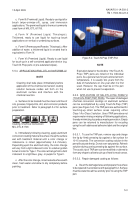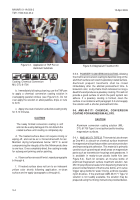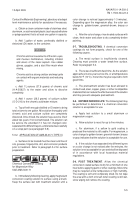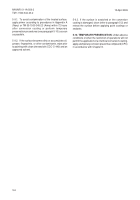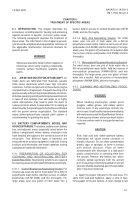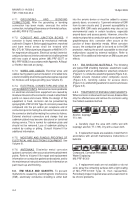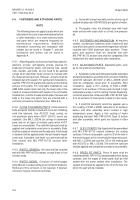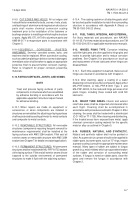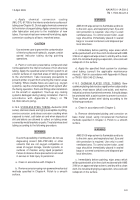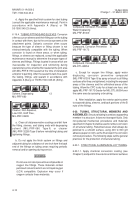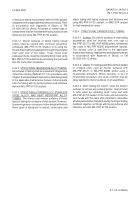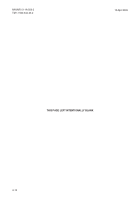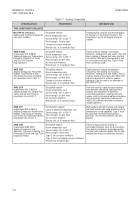TM-1-1500-344-23-2 - Page 111 of 240
6-7
NAVAIR 01-1A-509-2
TM 1-1500-344-23-2
15 April 2009
6-9.9. CUT EDGES AND HOLES. All cut edges and
holes drilled or reworked for bolts, screws, rivets, studs,
and bushings of aluminum and magnesium structure or
parts shall receive chemical conversion coating
treatment prior to the installation of the fasteners or
bushings and prior to installing or refinishing the structure
or parts. Apply MIL-DTL-81706 to aluminum parts and
AMS-M-3171 to magnesium parts in accordance with
Chapter 5.
6-9.10.SEVERELY
CORRODED
(RUSTED)
HARDWARE. Severely corroded screws, bolts, and
washers shall be replaced. When a protective coating,
such as cadmium plating on bolts or screws is damaged,
immediate action shall be taken to apply an appropriate
protective finish to prevent further corrosion (rusting).
Refer to Chapter 8 for proper corrosion preventive
materials.
6-10. FAYING SURFACES, JOINTS, AND SEAMS.
NOTE
Treat and process faying surfaces of parts,
components, or structures which are assembled
by adhesive bonding in accordance with the
applicable equipment structural repair manual
for adhesive bonding.
6-10.1. When repairs are made on equipment or
accessories, or when components are installed or
structures are reinstalled, the attaching or faying surfaces
shall be protected by sealing all metal-to-metal contacts
and composite-to-metal contacts.
6-10.2. REMOVABLE STRUCTURES. All removable
structures (components requiring frequent removal for
maintenance requirements) shall be installed at the
faying surfaces with AMS 3284 sealant. Fillet seal all
exterior seams on removable structure with AMS 3284
sealant (see Chapter 7 for details on sealant application).
6-10.3. PERMANENT STRUCTURES. All permanent
structures shall be installed with MIL-PRF-81733 sealant
at the faying surface. Fillet seal all exterior seams (those
exposed to the outside environment) of permanent
structures to make it flush with the adjoining surface.
6-10.4. The coating system on all attaching parts shall
be touched up after installation to match the surrounding
structure in accordance with Appendix A (Navy) or
TM 55-1500-345-23 (Army).
6-11. FUEL TANKS, INTEGRAL AND EXTERNAL.
For Navy materials and procedures, see NAVAIR
01-1A-35. For Army materials and procedures, see TM
55-1500-204-25/1 or applicable maintenance manuals.
6-12. HINGES, PIANO TYPE.
Corrosion inhibiting
solid film lubricants are often applied to hinge pins and
nodes to provide lubrication and to reduce corrosion
problems. See Chapter 2 for procedures on touch-up
and replacement of these lubricants when hinges are
disassembled.
6-12.1. Each time equipment is washed, make sure all
hinges are cleaned in accordance with Chapter 2.
6-12.2. After washing, apply a coating of a water
displacing corrosion preventive compound. Apply either
MIL-PRF-63460, or MIL-PRF-81309 Type II and
MIL-PRF-32033, to the node and hinge pin areas of all
piano hinges, including those coated with solid film
lubricants.
6-13. RELIEF TUBE AREAS.
Interior and exterior
relief tube areas shall be inspected and cleaned after
each flight. Cleaning shall be accomplished in
accordance with procedures outlined in Chapter 2. After
cleaning, the areas shall be treated with a disinfectant
(O-D-1435 or TT-I-735). After cleaning and disinfecting,
if the treated areas have exposed bare metal, apply
chemical conversion coating material for the specific
metal or alloy as outlined in Chapter 5.
6-14.
RUBBER, NATURAL AND SYNTHETIC.
Natural and synthetic rubber shall not be painted or
oiled. As a general rule, grease should not be applied to
rubber parts, but some parts, such as "O" rings, require
a grease coating (consult the appropriate maintenance
manual). Many types of rubber are subject to fungus
growth (e.g. mold, mildew) which can cause deterioration
of the rubber and corrosion of surrounding metal
surfaces. If fungus is noted on rubber parts, clean the
parts and remove the fungus in accordance with
Chapter 2.
Back to Top

